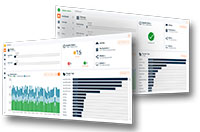
Quantum ATFS
Quantum Corp. has unveiled its all-new data and storage management platform - Quantum ATFS. It is the first network-attached storage platform to integrate real-time data classification and insights with the needs of applications, determining how storage resources are allocated and consumed. Data insights enable organizations to visualize data without the constraints of a file system, automate purposeful data placement based on policies, and optimize resources using just-in-time data movement policies. The ability to support the needs of data and applications on premise or in the cloud advances Quantum’s strategy to be the leading provider of management and storage services for unstructured data anywhere.
“The engineering teams at Quantum worked with storage experts to address the many challenges IT teams face with growing storage needs. They designed an innovative and unchained solution with cutting edge technology, data provenance and analytics to provide a storage platform that works for IT, instead of IT that works for storage,” said Jeffrey McDonald, PhD, Director of Information Technology, The Hormel Institute.
Optimize Storage Resources Based on and For the Benefit of Data
Customers today are performing “unnatural acts” to manage their data – guessing at capacity and where data lives, or crawling file systems for days to find what is needed by the business. They are often uncertain about what they can delete and when they can delete it. The results are silos of data, and a loss of control and visibility. ATFS (All-Terrain File System) meets this challenge. It is designed to ensure just-in-time purposeful placement of data, meeting the performance, resiliency, availability, and access demands of applications and workflows. As a result, ATFS delivers a consistent end user experience to deploy resources on premise or in the cloud.
By leveraging data classification, metadata and business-oriented tagging to streamline and optimize storage resource consumption, ATFS transforms storage economics, eliminating the premium organizations pay for performance. It is designed to manage hardware resources as a service to the application when and where it is needed it at scale.
“The ATFS system we have at 5 Guys Named Moe is the backbone of our extremely high bandwidth cloud data migration work,” said Eric A. Reid, head of post-production, 5 Guys Named Moe, Inc. “Using the metadata tagging built into the ATFS platform allows us to prioritize data efficiently and make sure that NVMe space is automatically allocated to the most resource intensive tasks without any manual input. This reduces costs overall while ensuring we have the right balance of storage space and high-end performance available for our workflows.”
Predictable, Consistent Performance
ATFS ingests data, which can be placed into flash, bulk or the cloud based on policies, application defined tags or manually. Performance may be tuned based on the size of the active data set. Automated policies place data “just-in-time” to support workloads while achieving greater efficiencies and improved productivity per unit of storage.
Seamless Cloud Collaboration and Data Mobility
By automating data classification and placement, ATFS serves a wide range of use cases:
Automate Application Workflows: Integrate with asset management tools, schedulers, and other applications to automate tasks using API in life sciences, media and entertainment, finance, and more.
• Active Data Retention: Metadata and tags simplify access to data over time.
• Deploy Resources in the Cloud: Burst into the cloud using cloud-based applications or use ATFS for large data set retention.
• Collaboration: Secure data sharing across the organization and externally without creating duplicates.
• Control Data: Execute on retention, protection, and access guidelines per regulations, best practices, to ensure data provenance.